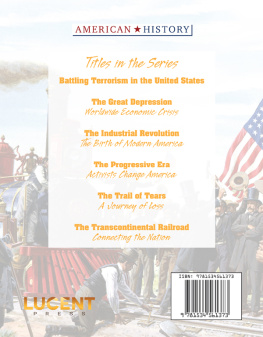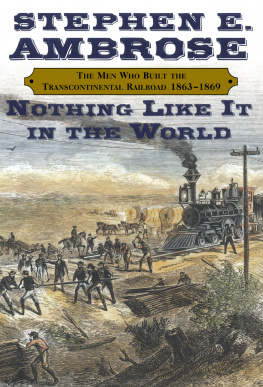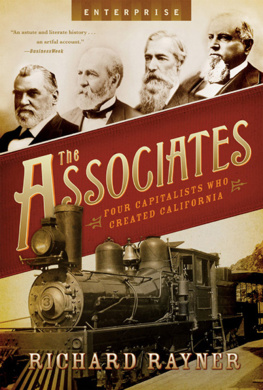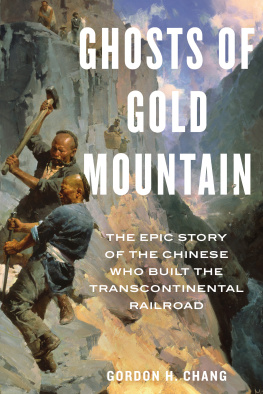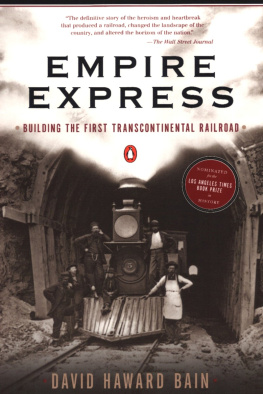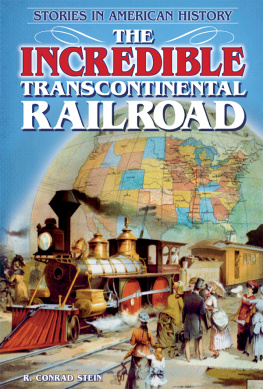ASIAN AMERICA
A series edited by Gordon H. Chang

Central Pacific Railroad Line
The Chinese and the Iron Road
BUILDING THE TRANSCONTINENTAL RAILROAD
EDITED BY
Gordon H. Chang and Shelley Fisher Fishkin, with Hilton Obenzinger and Roland Hsu
STANFORD UNIVERSITY PRESS
STANFORD, CALIFORNIA
Stanford University Press
Stanford, California
2019 by the Board of Trustees of the Leland Stanford Junior University.
All rights reserved.
No part of this book may be reproduced or transmitted in any form or by any means, electronic or mechanical, including photocopying and recording, or in any information storage or retrieval system without the prior written permission of Stanford University Press.
Printed in the United States of America on acid-free, archival-quality paper
Library of Congress Cataloging-in-Publication Data
Names: Chang, Gordon H., editor. | Fishkin, Shelley Fisher, editor. | Obenzinger, Hilton, contributor. | Hsu, Roland, 1961- contributor.
Title: The Chinese and the iron road : building the transcontinental railroad / edited by Gordon H. Chang and Shelley Fisher Fishkin, with Hilton Obenzinger and Roland Hsu.
Other titles: Asian America.
Description: Stanford, California : Stanford University Press, 2019. | Series: Asian America | Includes bibliographical references and index.
Identifiers: LCCN 2018037786 | ISBN 9781503608290 (cloth : alk. paper) | ISBN 9781503609242 (pbk.) | ISBN 9781503609259 (epub)
Subjects: LCSH: Railroad construction workersWest (U.S.)History19th century. | Foreign workers, ChineseWest (U.S.)History19th century. | Central Pacific Railroad CompanyEmployeesHistory. | ChinaEmigration and immigrationHistory19th century. | ChineseWest (U.S.)History19th century. | West (U.S.)History19th century.
Classification: LCC HD8039.R3152 C49 2019 | DDC 331.6/251097509034dc23 LC record available at https://lccn.loc.gov/2018037786
Cover design: Susan Zucker
Cover photo: China Section Gang Promontory, J. B. Silvis. Denver Public Library.
Typeset by BookMatters in 11/14 Garamond Premier Pro
Contents
GORDON H. CHANG, SHELLEY FISHER FISHKIN, AND HILTON OBENZINGER
GORDON H. CHANG
EVELYN HU-DEHART
ZHANG GUOXIONG, WITH ROLAND HSU
YUAN DING, WITH ROLAND HSU
LIU JIN, WITH ROLAND HSU
BARBARA L. VOSS
BARBARA L. VOSS
KELLY J. DIXON WITH CONTRIBUTIONS BY GARY WEISZ, CHRISTOPHER MERRITT, ROBERT WEAVER, AND JAMES BARD
J. RYAN KENNEDY, SARAH HEFFNER, VIRGINIA POPPER, RYAN P. HARROD, AND JOHN J. CRANDALL
KATHRYN GIN LUM
HSINYA HUANG
DENISE KHOR
GREG ROBINSON
WILLIAM GOW
YUAN SHU
PIN-CHIA FENG
SHELLEY FISHER FISHKIN
ZHONGPING CHEN
SUE FAWN CHUNG
BETH LEW-WILLIAMS
GORDON H. CHANG
Maps, Figures, and Tables
Maps
Figures
Tables
)
Note on Romanization
It is a challenge to standardize the romanization of Chinese names. We have attempted to use the pinyin system throughout the book. In certain chapters, where appropriate, the names of persons, institutions, and places are romanized in the way that they most frequently appear in historical Western-language documents.
Introduction
GORDON H. CHANG, SHELLEY FISHER FISHKIN, AND HILTON OBENZINGER
The Chinese railroad workers who built Americas first transcontinental railroad and then went on to help build scores of other railroads in North America have been largely invisible on both sides of the Pacific. In The Chinese and the Iron Road, scholars based in North America and Asia who are part of Stanfords Chinese Railroad Workers in North America Project deploy transnational perspectives drawn from a wide range of disciplines to explore the many unanswered questions that we have: Who were these workers? Why did they come? What did they experience? How did they live? What were their spiritual beliefs? What did they do after the railroad was completed? What is their place in cultural memory? The Chinese and the Iron Road aims to recover this neglected chapter of the past more fully than ever before.
* * *
In 1862 with the passage of the Pacific Railway Act, the Central Pacific Railroad Company (CPRR) was chartered to build the western portion of what became known as the first transcontinental railroad, east from Sacramento. Work began in the fall of 1863. The eastern portion of the line, built by the Union Pacific Railroad Company (UPRR), required laying tracks across vast flat expanses of prairie, but the western portion of the line required cutting through the Sierra Nevadachipping and blasting deep rock cuts, dumping tons of rocks for fills, carving fifteen separate tunnels through long stretches of solid granite, and constructing trestles across deep canyons. At first, most of the workers on both lines were of European descent, especially Irish. But by the middle of 1864 white workers on the CPRR were abandoning the backbreaking work of railroad building in droves to seek their fortunes elsewhere, including the silver mines of the Comstock Lode. The Central Pacifics president, Leland Stanford, and his fellow ownersCollis Huntington, Charles Crocker, and Mark Hopkins (they called themselves the Associates but are often referred to as the Big Four)faced a crisis: work had stalled with less than fifty miles of the railroad completed. Many at the time thought that the CPRR would not get through the Sierra Nevada, let alone out of California. The dire manpower shortage jeopardized the entire enterprise.
In early 1864 the Central Pacific had decided to try a few dozen Chinese workers from nearby mining communities. By late 1865 Chinese workers composed the vast majority of the labor force on the Central Pacific and numbered in the thousands. As Leland Stanford reported in a letter to US President Andrew Johnson that year, Without them it would be impossible to complete the western portion of this great national enterprise, within the time required by the Acts of Congress.
Despite their superlative efficiency, endurance, intelligence, and dependability, the Chinese worked longer hours for less pay than their white peers. Historians estimate that they cost the company between one-half and two-thirds of what white workers cost.
The labor of Chinese workers, who eventually numbered between ten thousand and fifteen thousand at the highest point (and perhaps up to twenty thousand in total over time) made it possible to cross the country in a matter of days instead of months, paved the way for new waves of settlers to come out west, and provided a much less costly way to transport goods across the continent. Their work helped speed Americas entry onto the world scene as a modern nation that connected the Atlantic and Pacific Oceans. Their labor also created vast wealth for the CPRRs four principals, including the fortune with which Leland Stanford would found Stanford University some two decades after the railroads completion. But despite the importance of their work, the Chinese workers themselves are a shadowy presence in much of the written history of the transcontinental railroad.
The Chinese Railroad Workers in North America Project at Stanford, from which this book originates, began in 2012 to address this void in historical understanding. It was the first comprehensive effort to recover and interpret the work of the Chinese railroad workers and became the largest effort to study any aspect of nineteenth-century Chinese American history generally. The projects objective was to try to recover as much as possible the history of the lived experience of the Chinese workers themselves. Eventually, more than one hundred scholars in North America and Asia from a wide variety of disciplines, including American studies, anthropology, archaeology, cultural and literary studies, heritage studies, and history, collaborated to locate and study as much primary material as possible. We hoped to locate new textual evidence, in English, Chinese, and other languages, but we understood early in the project that creative intellectual methodologies would be necessary to advance our understanding of the lives of these workers. Given that many other able and dedicated researchers had tried and failed for many decades before us to uncover a hidden cache of textual material, we could not assume that mighty efforts and good fortune would lead us to such a trove.
Next page



